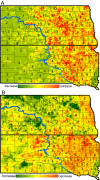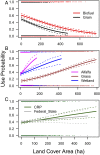Land-use change reduces habitat suitability for supporting managed honey bee colonies in the Northern Great Plains
- PMID: 27573824
- PMCID: PMC5027442
- DOI: 10.1073/pnas.1603481113
Land-use change reduces habitat suitability for supporting managed honey bee colonies in the Northern Great Plains
Abstract
Human reliance on insect pollination services continues to increase even as pollinator populations exhibit global declines. Increased commodity crop prices and federal subsidies for biofuel crops, such as corn and soybeans, have contributed to rapid land-use change in the US Northern Great Plains (NGP), changes that may jeopardize habitat for honey bees in a part of the country that supports >40% of the US colony stock. We investigated changes in biofuel crop production and grassland land covers surrounding ∼18,000 registered commercial apiaries in North and South Dakota from 2006 to 2014. We then developed habitat selection models to identify remotely sensed land-cover and land-use features that influence apiary site selection by Dakota beekeepers. Our study demonstrates a continual increase in biofuel crops, totaling 1.2 Mha, around registered apiary locations in North and South Dakota. Such crops were avoided by commercial beekeepers when selecting apiary sites in this region. Furthermore, our analysis reveals how grasslands that beekeepers target when selecting commercial apiary locations are becoming less common in eastern North and South Dakota, changes that may have lasting impact on pollinator conservation efforts. Our study highlights how land-use change in the NGP is altering the landscape in ways that are seemingly less conducive to beekeeping. Our models can be used to guide future conservation efforts highlighted in the US national pollinator health strategy by identifying areas that support high densities of commercial apiaries and that have exhibited significant land-use changes.
Keywords: Apis mellifera; apiary selection models; land use; land-cover trends; pollinators.
Conflict of interest statement
The authors declare no conflict of interest.
Figures








References
-
- Kearns CA, Inouye DW, Waser NM. Endangered mutualisms: The conservation of plant-pollinator interactions. Annu Rev Ecol Syst. 1998;29(1):83–112.
-
- Aizen MA, Harder LD. The global stock of domesticated honey bees is growing slower than agricultural demand for pollination. Curr Biol. 2009;19(11):915–918. - PubMed
-
- Potts SG, et al. Global pollinator declines: Trends, impacts and drivers. Trends Ecol Evol. 2010;25(6):345–353. - PubMed
Publication types
MeSH terms
LinkOut - more resources
Full Text Sources
Other Literature Sources

